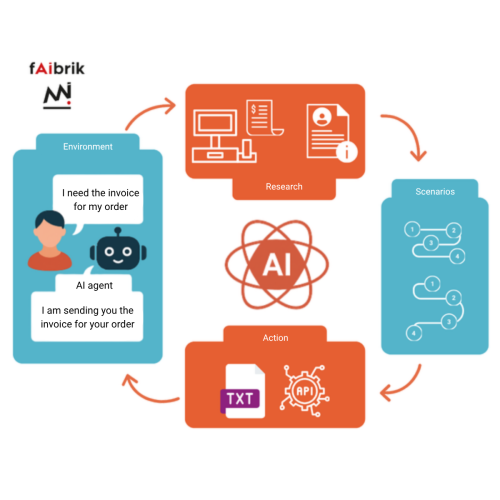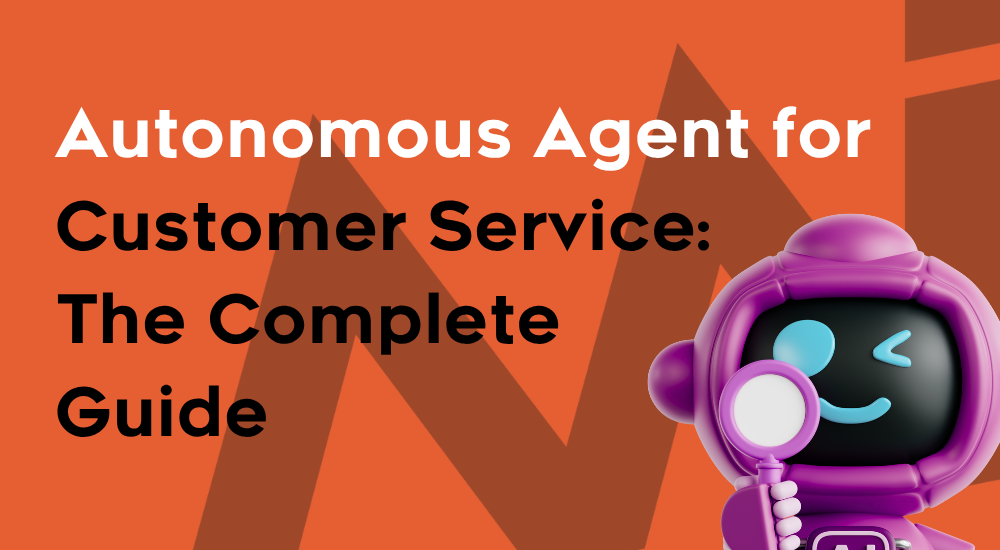Artificial intelligence has transformed how we search, work, and even consume. New developments follow one another, tools evolve rapidly and become increasingly “intelligent”. The promises are numerous: time savings, increased productivity, cost reduction… but between promises, sometimes excessive enthusiasm, and field reality, it’s not always easy to navigate. We offer you a clear definition of autonomous agents to help you understand what they are, what they can do, and form your own opinion.
What is an autonomous agent?
An autonomous agent is software that uses artificial intelligence to observe its environment, make decisions, and act autonomously according to predefined objectives. The goal of an autonomous agent is to function without human intervention while acting in its owner’s best interest.
Also called AI agents, these systems can range from simple programs driven by fixed rules to much more advanced solutions capable of adaptation and reasoning. These agents can therefore be seen as simple assistants for performing repetitive tasks, or as real solutions capable of imitating human behaviors, or even accomplishing tasks that a human couldn’t handle alone due to lack of time, data, or processing capacity.
Autonomous agents vs. traditional software
What distinguishes autonomous agents from more conventional software is their ability to make rational decisions based on their environment to achieve a specific objective. This environment can include internal knowledge bases (documents, business data, connected tools), but also public sources such as web pages, FAQs, or documentation accessible online.
Concretely, the agent interacts with its environment, considers all possible scenarios to achieve its objective, analyzes them, then creates a sequence of tasks to reach that goal. It then defines the steps to follow and executes them by adapting if some don’t work as expected.
What makes it 100% autonomous is that it doesn’t need an action plan defined by a human to perform these tasks. The agent can handle the unexpected alone, without needing to anticipate all possible conditions from the start.
You may have already used one without realizing it. Indeed, on tools like ChatGPT, Perplexity, or Gemini, certain in-depth searches are handled by autonomous agents. They break down your question, analyze its meaning, explore multiple sources, then synthesize an answer as precise as possible. This actually explains why some responses take a little longer to arrive.
These agents overcome certain limitations of traditional software, which follows predictable fixed scenarios without real-time adaptation capability.

Multi-agent systems
An autonomous agent can also collaborate with other autonomous agents to achieve a common goal. Each agent has its specific role and domain of expertise to accomplish their mission. Thus, a true artificial intelligence organization forms within the company. At fAIbrik, we implemented such a system for one of our clients, combining two agents. The first generates content, while the second corrects and optimizes it. Both agents interact until all criteria defined by the client are validated.
The role of autonomous agents in customer service
Customer service has become an essential pillar for businesses, and artificial intelligence naturally finds its place there. It already allows for analyzing, prioritizing, and assigning requests while considerably reducing response times. However, when poorly configured, it can lack nuance, empathy, or effectiveness in ticket resolution. Customer expectations, increasingly high and demanding, force companies to adapt to new standards. According to the latest Accenture study on customer service, 35% of respondents stated they feared AI would further degrade customer service quality in the coming years.
It’s in this context that autonomous agents generate interest. Their operation resembles that of a human: they analyze, think, and undertake appropriate tasks. For example, in a conversation related to a customer service problem, the agent can understand the request, act to satisfy the customer, and adapt to unforeseen cases, all while maintaining a consistent and empathetic tone.
These agents can intervene in both pre-sales and after-sales. They can take initiative in pre-sales to suggest products based on customer preferences or propose service improvements. As for after-sales, they’re capable of identifying a customer’s problem and proposing appropriate solutions to guarantee their satisfaction.
What are the benefits for my business?
Time savings
One of the first benefits of autonomous agents is time savings, for both customers and support teams. Available 24/7, these agents allow a company to remain continuously reachable without interruption. Processing is fast because the agent quickly understands the context, makes a real-time decision, and formulates a clear response without analysis or human validation delay. Your customers therefore benefit from almost immediate assistance, regardless of the time.
At fAIbrik, we created an autonomous agent for social landlord Haute Savoie Habitat. It directly answers tenants’ questions autonomously. Customer requests can be general or specific cases requiring data linked to a tenant file. The agent analyzes the request, identifies the required information level, then searches for answers in internal tools or public sources.
This case clearly illustrates the value of an autonomous agent in a context where requests are varied and difficult to predict. Where a script or decision tree would have reached its limits, the autonomous agent is capable of adapting to the situation by analyzing its environment and mobilizing available tools, without depending on a pre-written scenario.
Ability to evolve in complex environments
Their capacity for analysis, reasoning, and prediction makes them capable of adapting to complex, dynamic, and sometimes unpredictable environments. They can handle a large volume of information while maintaining consistent execution quality.
Where humans can be limited by fatigue, information overload, or scenario complexity, the autonomous agent remains effective. It can process multiple data points, extract relevant elements, cross-reference sources, anticipate possible developments, and act accordingly. This allows companies to grow without burdening their processes or compromising delivered service quality.
Personalization
By accessing the company’s internal tools, the autonomous agent can retrieve useful customer information and adapt its message accordingly. It considers exchange history, customer profile, or even the company’s communication tone. Responses are then consistent, personalized, and aligned with brand image.
The agent is also capable of adopting natural language, close to that of a human. It can rephrase, nuance, express empathy, and even adjust its language level according to the interlocutor. For the customer, the exchange remains fluid and natural, without giving the impression of talking to a machine.
What are the limitations of autonomous agents?
Loss of human expertise
AI agents make their decisions based on statistical analyses. Their approach is logical, rational, and optimized to achieve a specific objective. But this operating mode leaves little room for intuition, professional experience, or human common sense.
Where a customer advisor relies on their experience, field knowledge, and similar cases, the autonomous agent follows a purely algorithmic approach. It can therefore make statistically effective decisions, but which miss certain subtleties. The risk is losing the richness of human interactions: empathy, analytical finesse, or the ability to think outside the box to solve a problem creatively.
Cost
The cost of creating and operating autonomous agents by AI model providers such as OpenAI, Mistral AI, or Anthropic is significant. This is therefore a criterion to carefully consider before launching.
Indeed, repetitive customer service tasks such as order tracking, answering frequent questions, automatic responses to customer reviews, or even sending an invoice can easily be handled by traditional software, which is less expensive and just as effective.
Moreover, even if an autonomous agent has a form of memory, it systematically reanalyzes its environment with each new interaction. This means its complete reflection and action process is relaunched each time, which mobilizes more resources… and can weigh on the budget.
Data integrity
Entrusting tasks to an autonomous agent also means giving it access to your tools and therefore your customers’ data. If you use models provided by third-party companies, this openness can represent a risk in terms of security and confidentiality.
To limit these risks, it’s essential to clearly define what the agent can or cannot do. This involves rigorous configuration of its environment, but also solid knowledge of data protection rules, particularly GDPR regulations. A powerful AI, poorly supervised, can quickly become a vulnerability point.
What is the risk of using an autonomous agent when it's not necessary?
It can be tempting to use an autonomous agent to automate certain simple tasks. However, when it involves a deterministic process, that is, a sequence of always identical actions, a conventional computing solution is often more appropriate. Entrusting this type of task to an AI agent, which relies on probabilities, presents two risks: first, that of deviating from the defined process, even if well-trained; second, that of unnecessarily consuming computing and energy resources. The autonomous agent should therefore remain a choice justified by the use case’s complexity, at risk of making a poor technological choice.
What technical aspects should you know?
To properly understand how an autonomous agent works, you need to know three essential building blocks: NLP, LLMs, and deep learning. NLP (natural language processing) allows the agent to understand what a customer says: it identifies intention, key information, and message tone. LLMs go further by generating appropriate and natural responses. These models rely on deep learning, a technology that allows them to learn from billions of texts and adapt to different contexts. This is what makes an agent capable not only of responding but also of deciding, improving, and handling varied situations with language close to that of a human.
To be truly useful, an autonomous agent cannot function “message by message.” It needs contextual memory: this is what allows it to follow the thread of a conversation, remember what a customer said a few messages earlier, or keep important elements in mind like an order number or specific request. In parallel, the agent can also rely on a knowledge base, a structured set of articles, rules, or documents to fetch precise answers or verify information before responding. It’s this combination between context understanding and access to the right information that allows the agent to offer a coherent, reliable, and truly personalized response.
Conclusion
Before launching, it’s essential to determine the extent of your needs. If your processes are clear, repetitive, easy to model in a decision tree, and everything works via API-connected tools, then conventional programmed software can largely suffice.
On the other hand, if you need to handle unpredictable situations, complex environments, natural language requests, or actions that fall outside the usual framework, autonomous agents are an option to seriously consider.
And if you’re hesitating between the two, you can count on fAibrik. Our AI platform for customer service adapts to your uses, whether simple automations or more advanced agents. We help you make the right choice based on your needs, tools, and ambitions.
